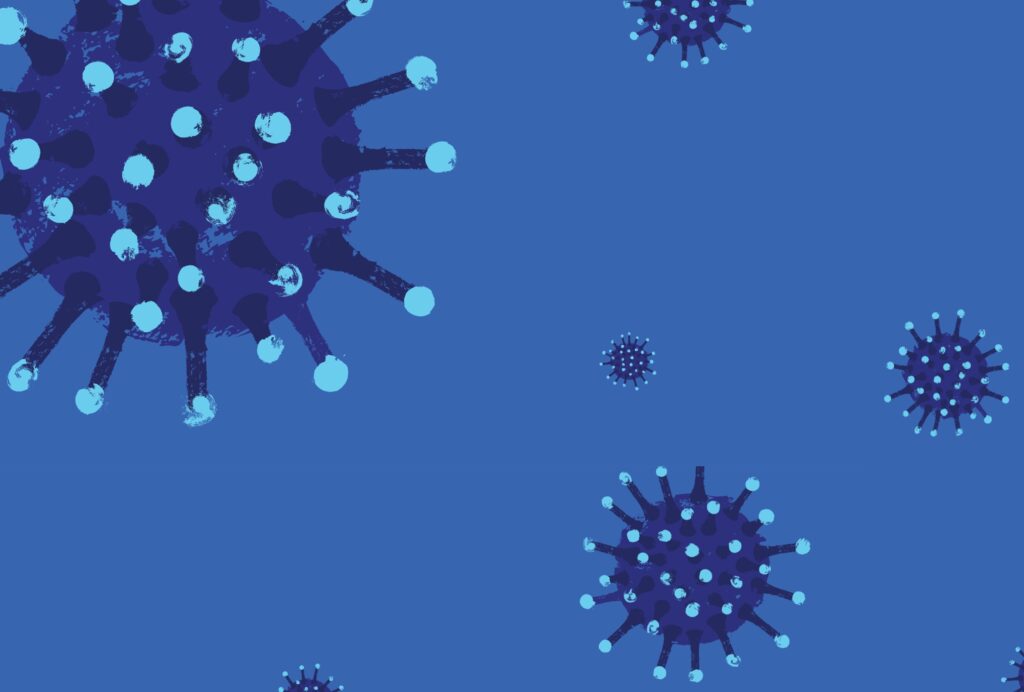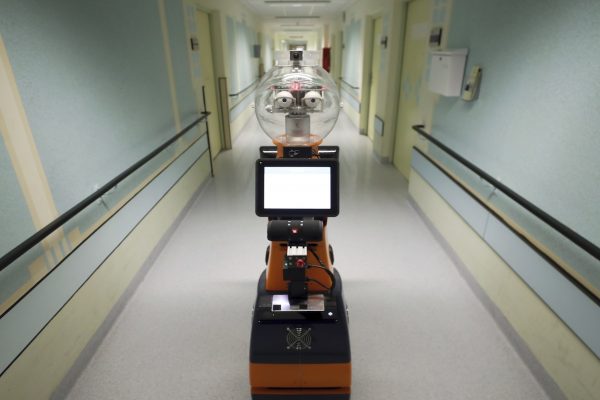Two weeks ago, Mass General Brigham—one of the largest health systems in the United States and where I am training as a resident physician—joined the growing ranks of hospitals across the country instituting COVID-19 vaccine mandates.
There is good evidence that vaccine mandates work. According to CDC data on the 2018–2019 flu season, influenza vaccination coverage was nearly perfect—97.7 percent—among health care workers whose employers required it. But there is another side to this story: among those who work in settings where vaccination was not required, promoted, or offered on-site—accounting for nearly one-sixth of all health care workers—fewer than half were vaccinated. Some might ask why it should take a mandate for health care workers to get vaccinated. After all, we have workplace access to the vaccine, we possess extensive medical knowledge, and our line of work is altruistic, centered around caring for others. How is it possible to work in this field and refuse to get vaccinated?
These observations fail to account for the social and economic conditions that shape individual behavior in the workplace. Health care workers are not a monolith—quite the contrary. Our health care systems are built on stark hierarchies, often along lines of race and gender. When I walk into the hospital, I find nurses, technicians, and physicians lined up at the elevator, six feet apart and entering elevators only a few at a time. It is striking that people barely speak or acknowledge each other’s presence. This silence, too, is a form of social distance, and it long predates the pandemic. We are a heterogeneous group, hailing from very different socioeconomic and demographic backgrounds and enduring materially different working conditions and relations with our employers.
These differences ultimately shape attitudes toward workplace initiatives, including vaccination efforts. Trust is bound to be imperfect in an environment of unequal treatment. This is not to deny that mandates are an essential public health tool. But to be better prepared for future epidemics, ensure patient safety, and foster broader trust of medical institutions, health systems should also work diligently to address these more fundamental factors shaping vaccine hesitancy among their workers.
Sociologists have long defined “social distance” as the degree of acceptance of social interactions between individuals on the basis of belonging to different social groups (such as race, gender, and class). I first noticed these forms of social distance in the hospital as a medical student. My residents and attending physicians rarely acknowledged the technicians in the hospital as they walked down the hallway emptying trash cans or transported patients to their procedures. This specific health care hierarchy is both deeply racialized and deeply gendered. Black and Hispanic people are disproportionately represented among lower-wage health care workers, and women make up most of the health care workforce, especially the non-physician workforce.
Unfortunately, this social distance among health care workers is mirrored in COVID-19 vaccine attitudes and uptake. A large, multistate study published in February included a wide variety of health care workers and found that higher education and income levels best predicted intention to receive the vaccine. Another study from Stanford University and the University of California, San Francisco, found that, compared to white respondents, Black, Hispanic, and Asian health care workers were significantly less likely to report an intention to take the COVID-19 vaccine and significantly more likely to endorse reasons to not get vaccinated—including less confidence in the vaccine’s effectiveness in preventing COVID-19, less trust in the companies making the vaccine, and more suspicion that the government rushed the approval process. These disparities do not differ significantly from what is observed in the general population; and they are congruent with my observations as a medical student when the vaccines first became available. The few hospital friends I reached out to about the vaccine were staunchly opposed to getting it. They didn’t trust the novel vaccine, they said, it was developed too fast; they’d rather rely on wearing their masks.
How do we bridge this gap between health care workers, who work in the same building, yet have such different attitudes toward vaccination?
First, we must confront the social distance between health care workers head on. Recognizing this, Black physicians at the Hospital University of Pennsylvania started an initiative earlier this year consisting of daily huddles with physicians and staff groups that have a high proportion of Black employees. Success hinged on the presence of at least one Black physician during each huddle, and they shared their experiences getting the vaccine and answered any questions from the staff. Information sharing through social networks is a key influence on people’s attitudes toward the vaccine. At the same time, this influence relies on a baseline level of trust. In settings where there is little trust between low-wage health care workers and those further up the hierarchy, these huddles might have little to no impact.
Unfortunately, low-wage health care workers often feel devalued at work. In her book Flatlining: Race, Work, and Health Care in the New Economy (2019), sociologist Adia Harvey Wingfield reports that those with greater authority in hospitals, including managers, nurses, and physicians, often discriminate against Black low-wage health care workers—from assigning them additional tasks relative to their white peers to assuming their incompetence. Harvey Wingfield also highlights the phenomenon of “racial outsourcing,” whereby health care institutions rely on the labor of their employees of color to make their initiatives more palatable to communities (or employees) of color without making significant structural changes to their practices.
Beyond fostering more harmonious and integrated workplaces that facilitate organic information-sharing, health systems should also make significant changes to their labor practices, especially as they relate to working conditions and employee remuneration. According to a 2019 study on health care workers’ attitudes towards the influenza vaccine, among nurses and nurse aides, a positive perception of management was associated with greater intent to get vaccinated, while feelings of compassion fatigue and a psychological contract breach were associated with lower vaccination intent. In other words, the propensity to get vaccinated appears to depend greatly on how health care workers perceive their working conditions.
For low-wage workers, those conditions were already bad before the pandemic, and they have only worsened. According to a 2019 study in the American Journal of Public Health, among low-wage health care workers, 35 percent of women and 23 percent of men earn less than $15 per hour, 7 percent of women and 8 percent of men have no insurance, and 10 percent of women and 7 percent of men are insured by Medicaid. These workers are disproportionately Black and Hispanic, and the majority are employed by hospitals. Some of the most vulnerable include home health aides, who work in one of the fastest-growing jobs in the United States. A recent study found that during the pandemic, home health care workers felt inadequately supported and generally invisible yet provided care at personal risk. Several studies have now highlighted work-related burnout among health care workers during the pandemic as well. In other words, low-wage workers are not well remunerated and often forced to live in poverty because of meager wages. The demands of their work during the pandemic only further strained them.
In combination with unfair wages and experiences of class- and race-based disrespect and devaluation at work, low-wage health care workers, especially those of color, have every reason to be suspicious of their employers. Evidence shows that employees’ perceptions of justice and fairness affect their trust in management and their commitment to their work. Living in poverty or struggling to make ends meet while those higher up the hierarchy are paid relatively ample wages and are dressed in high-status symbols at work can certainly alter workers’ perceptions of fairness. In these conditions, it is little surprise that already marginalized workers would express hesitancy, notwithstanding their knowledge and vital role in health care. After all, too few things in their daily experience suggest being adequately protected and cared for.
These conditions also impact workers’ families. In many communities, health systems are the largest employers. Women are overrepresented in the health care workforce and are more likely to be the medical decision-maker in their families. A total of 1.7 million female health care workers and their children live in poverty. Successful vaccination efforts among low-wage health care workers would therefore likely translate to an increase in vaccine uptake among their families and other members of their social networks. A study from the H1N1 pandemic found that individuals’ decisions to get vaccinated against the H1N1 flu were significantly influenced by social network ties. Given the gendered skew of the health care workforce and the role of women in household health decisions, health systems could play a tremendous role in increasing community vaccination levels, especially as COVID-19 vaccines become approved for children.
Health systems may be tempted to simply fall back on vaccine mandates; after all, they work. But investing in their workforce and their working conditions would pay long-term dividends. Working conditions not only affect workers themselves, but also the care that they provide. For nursing assistants, greater commitment to the job is associated with better quality of life for nursing home residents, while residents of nursing homes with higher nursing assistant turnover are at increased risk of pressure ulcers and urinary tract infections. In the COVID-19 context, nursing homes where staff were unionized (and therefore had greater bargaining power and voice in their working conditions) had a 30 percent relative decrease in the COVID-19 mortality rate compared with facilities without unions. Meanwhile, the dire shortage of nurses across U.S. hospitals is a direct consequence of the unsustainable and tragic conditions the health care workforce has endured during the pandemic. Overworked and under-supported, many have simply burnt out. These working conditions have an impact on health disparities, too. A recent study found that better nurse staffing is associated with higher survival rates for Black patients who experience in-hospital cardiac arrest: each additional patient per nurse lowered Black patients’ survival odds by 8 percent, but this was not the case for white patients.
To combat these conditions, health care systems should commit to substantive material changes—including paying a living wage, ensuring adequate staffing, and providing benefits such as health insurance coverage (shockingly, a quarter of low-wage Black and Hispanic health care workers are either uninsured or on Medicaid). A 2019 study in the American Journal of Public Health found that raising the minimum wage to $15 per hour would reduce federal poverty rates among female health care workers by somewhere between 27.1 and 50.3 percent. Since then many health systems have announced plans to raise starting hourly wages—a welcome but long overdue commitment. Last year, for example, the University of Pittsburgh Medical Center succumbed to over five years of protests from clergy and union workers in committing to a $15 minimum wage this year. While these are steps in the right direction, we must also recognize that a $15 hourly wage does not amount to a living wage in many metropolitan areas. In Boston, for instance, the living wage for one adult with zero children is estimated to be $19.17 (or almost $40,000 yearly), but the last publicly reported starting wages among the largest health systems—my employer included—remain far lower. Any serious effort to combat the material basis of medical distrust must begin by confronting these facts head on.
To be sure, some of the more visible instances of COVID-19 vaccine refusal among health care workers also include white nurses, who are not low-wage employees. (Consider the case at Houston Methodist hospital, where employees protested, sued their hospital for mandating the vaccine, and ultimately resigned or were fired.) There are certainly other causes of vaccine hesitancy, including mistrust in government competency. But these workers, highlighted in mainstream media, are in the minority. A survey of over 20,000 nurses from the American Nursing Academy found that, despite having initially expressed concerns about the speed at which the vaccines were developed, as of February 2021, 70 percent of nurses had received at least one vaccine dose. Attention and resources should instead be directed toward low-wage health care workers whose hesitancy is more closely tied to their working conditions.
I am thrilled that health care organizations and professional medical societies are recommending mandates for COVID-19 vaccines. But at the same time, I also long for a health care system that doesn’t have to force workers to get vaccinated and that earns the trust of the less privileged among us through safe and healthy working conditions, fair wages, and opportunity for upward mobility. A true politics of care for workers’ well-being—matched with the dollars to show it—would go a long way in addressing the racial, occupational, and class-based health disparities within the health care workforce. It must start now.








